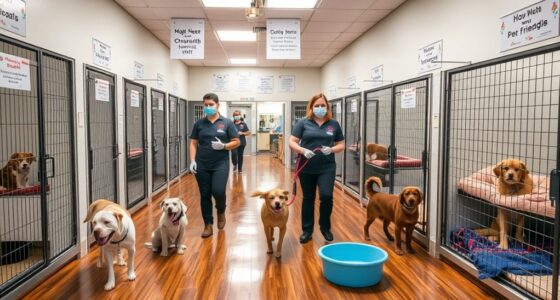To construct a pet-safe temporary enclosure, start by selecting sturdy wire panels or lightweight plastic fencing, secured with zip ties for stability. Use a solid base like plywood or a tarp, and double-check for sharp edges or broken parts. Place the enclosure away from hazards like electrical cords or toxic plants, and make certain all connections are tight. For more detailed tips on creating a safe and comfortable space, keep exploring options and safety measures.
Key Takeaways
- Use sturdy wire panels and secure zip ties to create a stable, escape-proof structure.
- Ensure all edges are smooth or covered to prevent pet injury from sharp corners.
- Place the enclosure on a solid, flat base like plywood or tarp for stability.
- Locate the setup away from hazards such as electrical cords and toxic plants.
- Regularly inspect and reinforce the enclosure to maintain safety and pet comfort.

When you need a safe space for your pet temporarily, building a secure enclosure is vital. Whether you’re preparing for a home renovation, a visit to the vet, or just giving your pet a designated area while you’re busy, a well-constructed temporary enclosure keeps them safe and comfortable. To guarantee your project is effective, start by gathering the right DIY materials. Depending on your pet’s size and activity level, common materials include sturdy wire panels, plastic fencing, zip ties, and a solid base like plywood or a tarp. Opt for materials that are easy to assemble, lightweight enough to move if needed, and durable to withstand your pet’s curiosity or escape attempts.
Before you begin, it’s essential to consider safety precautions. Check all materials for sharp edges or loose parts that could injure your pet. For example, if you’re using wire panels, smooth out any sharp points or cover them with protective caps. If you choose plastic fencing, verify that it’s free of cracks or broken areas. When setting up, guarantee that the enclosure is stable and secure; weak points can become escape routes or safety hazards. Avoid any materials that might be toxic if chewed or ingested, and steer clear of small gaps through which a curious pet could squeeze.
Check for sharp edges, loose parts, and toxic materials to ensure your pet’s safety.
As you assemble your enclosure, pay close attention to the height and sturdiness. For active or larger pets, a taller, reinforced structure prevents escapes and provides peace of mind. Make sure the base is solid and flat to prevent tipping or shifting. If you’re using a tarp or fabric as a floor, secure it tightly to avoid tripping hazards or gaps that your pet could dig through. For added safety, double-check that all connections—zip ties, clips, or fasteners—are tight and secure. Using appropriate safety precautions can significantly reduce the risk of accidents and injuries.
If your pet tends to chew or claw, consider adding additional barriers or padding around sharp edges. Also, place the enclosure away from hazards like electrical cords, toxic plants, or other household dangers. Remember, safety precautions aren’t just about the materials used but also about the setup process. Regularly inspect the enclosure during use, especially if your pet is particularly energetic or persistent. By carefully selecting DIY materials and observing safety precautions, you create a temporary space that’s both secure and comfortable for your pet. This not only protects your furry friend but also gives you peace of mind knowing they’re safe during your time apart.
Frequently Asked Questions
How Long Can a Temporary Enclosure Safely Contain a Pet?
You can typically keep a pet in a temporary enclosure safely for about 4 to 6 hours, but this depends on your pet’s comfort and enclosure maintenance. Guarantee the space is clean, secure, and offers water and some comfort items. Regularly check on your pet to prevent stress or discomfort. If needed, extend the time, but always prioritize your pet’s well-being and make sure the enclosure remains a safe, cozy environment.
What Materials Are Best to Prevent Escape or Injury?
Use durable fencing like galvanized metal or heavy-duty plastic to prevent escapes, ensuring it’s tall enough to stop your pet from jumping over. Add soft padding along the edges and corners to prevent injury if they bump into the enclosure. Secure all doors and openings tightly, and check regularly for any damage. This combination keeps your pet safe, comfortable, and secure during temporary setups.
How Do I Ensure Proper Ventilation in the Enclosure?
Think of your enclosure as a living, breathing space. To guarantee proper ventilation, you need to manage airflow like a gentle breeze. Use mesh panels or open sides to promote airflow management and prevent stuffiness. Ventilation tips include placing vents at different levels and avoiding overcrowding. This keeps fresh air circulating, helping your pet stay comfortable and safe, especially on warm days or during extended stays.
Can I Use the Enclosure Outdoors in All Weather Conditions?
You can use the enclosure outdoors in all weather conditions if it has good weather durability and is made from material safety. Make sure it’s weatherproof, with rust-resistant frames and waterproof covers, to withstand rain, snow, or sun. Check that the materials are non-toxic and safe for pets. Regularly inspect and maintain the enclosure to guarantee it continues to protect your pet in varying weather scenarios.
What Are Signs My Pet Is Stressed in the Enclosure?
You’ll notice signs of pet anxiety in their enclosure behavior, like pacing, whining, or scratching the sides. They might also hide or refuse to enter. If your pet shows these signs, it indicates stress. To help, make certain the enclosure is comfortable, safe, and familiar. Observe their reactions closely, and if stress persists, consider adjusting the environment or consulting a vet to reduce pet anxiety and improve enclosure comfort.
Conclusion
Now that you’ve built a sturdy, pet-safe temporary enclosure, you’ve created a fortress that even the most curious pet couldn’t escape. With your careful choices, you’ve turned a simple space into a safe haven, protecting your furry friend from hazards and chaos. Remember, your effort can turn any ordinary area into a mini paradise—more secure than Fort Knox! Keep an eye on your pet and enjoy peace of mind, knowing you’ve built a safe, cozy space just for them.










